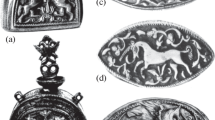Abstract
The method of natural sciences of replication (reproduction of historical technologies) is promising in the study of cultural-heritage objects. By applying this method, models of the method of information recording are obtained, made using authentic raw materials and in accordance with historical chemical techniques (cold and hot extraction, fermentation, reactions with the formation of colloidal solutions in open reaction vessels at atmospheric pressure). The purpose of the study is to trace the dynamics of changes in the properties of model ink using the methods of natural sciences, in particular chemistry and physics. This is necessary to understand the causes of damage to cultural-heritage objects, such as written artifacts of the 15th–18th centuries. The use of replication is the only way to apply in research not only nondestructive, but also destructive natural-science methods. The results of replication of ten ink formulations of two groups are presented. In the first, iron vitriol served as a source of iron ions, in the second, rusty iron. The yellowing and color characteristics in the process of light-induced aging, chemical properties and microstructure of the ink are determined. The characteristic features of each of the groups are described.





Similar content being viewed by others
REFERENCES
V. A. Shchavinskii, Essays on the History of Painting Technique and Paint Technology in Ancient Rus’ (Ogiz, Moscow, 1935) [in Russian].
V. G. Georgievskii, in Proceedings of the Conference on the History of Natural Science, December 24–26, 1946 (Leningrad, 1948), p. 235.
V. S. Mefod’eva, Khrizograf, No. 1, 347 (2003).
N. F. Palamar’, P. E. Kandyba, and A. G. Tolstikov, Vestn. Arkhiv., No. 2, 183 (2016).
D. O. Tsypkin, E. Yu. Tereshchenko, A. P. Balachenkova, A. L. Vasiliev, E. A. Lyakhovitsky, E. B. Yatsishina, and M. V. Kovalchuk, Nanotechnol. Russ. 15, 542 (2020).
Code of Written Sources on the Technique of Old Russian Painting, Books and Artistic Crafts in the Lists of the 15th–19th Centuries, Ed. by Yu. I. Grenberg (Pushkinskii Fond, St. Petersburg, 1995) [in Russian].
Funding
Research on the replication of historical ink was carried out with financial support of the Ministry of Science and Higher Education of the Russian Federation (grant no. 075-11-2021-087 dated December 22, 2021 (project 15.SIN.21.0013).
Author information
Authors and Affiliations
Corresponding author
Rights and permissions
About this article
Cite this article
Bystrova, E.S., Lotsmanova, E.M. Experience of Replicating Historical Inks of the 15th–18th Centuries: Studying the Properties of Model Samples. Nanotechnol Russia 17, 708–714 (2022). https://doi.org/10.1134/S2635167622050044
Received:
Revised:
Accepted:
Published:
Issue Date:
DOI: https://doi.org/10.1134/S2635167622050044




